The topic of this article may not meet Wikipedia's general notability guideline .(October 2024) |

Gottex is an Israeli goods designer swimwear manufacturer based in Tel Aviv.
The topic of this article may not meet Wikipedia's general notability guideline .(October 2024) |

Gottex is an Israeli goods designer swimwear manufacturer based in Tel Aviv.
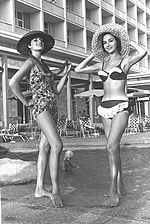
Gottex was founded in Tel Aviv, Israel, in 1956 by Lea Gottlieb, who headed the design team until 1998. She adapted her expertise as a raincoat manufacturer to create a pioneering swimsuit company. [1]
She sold her wedding ring for capital, bought fabric, borrowed a sewing machine and began to design swimsuits that were unique to Israel, inspired by the local Middle-Eastern light and colors: "the aqua of the Mediterranean, the golden yellow of the desert, the blue of Lake Tiberias, the pink of Jerusalem stone and the greens of the Galilee." [1]

During the German occupation of Hungary, Gottlieb was forced to move with her husband and daughters from one hiding place to another. To avoid being recognized as a Jew when passing through checkpoints, she used to tuck her head in a bouquet of flowers. She said that the flower motifs in her designs were a tribute to the flowers that saved her life. [2]
In Gottlieb's vision, Gottex collections can be worn "from pool to the bar", and then to a restaurant or cocktail parties. In addition to swimsuits, Gottex produces caftans, tunics and trousers, combining swimwear and beachwear. [1] Gottex is a pioneer of swimsuits with hard-cup bras. [3] Gottex is known for using innovative fabrics. It was the first manufacturer to introduce spandex. [4]
In 1975, she was contacted by the fashion houses of Yves St. Laurent and Pierre Cardin, which sought to manufacture her swimsuits under their names. Instead, she expanded into men's and children's swimwear, bed linens, towels and drapes. [5]
By the 1980s, Gottex swimsuits were being worn by Diana, Princess of Wales, Spain's Queen Sofia, Elizabeth Taylor, and Brooke Shields. [6]
In 1997, Gottex was acquired by the Lev Leviev of the Africa-Israel Group. Lea Gottlieb ran the design department for another year and then left to start another fashion company under her own name at the age of 85, where she worked until she was 90. [5]
In 1993, Gottex was America's top swimsuit import. [3] According to the Israel Export Institute, exports of Israeli swimwear totaled $44 million in 1999. [7]
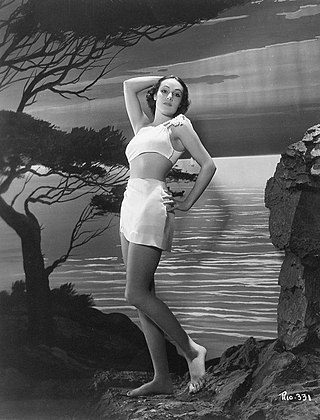
A bikini is a two-piece swimsuit primarily worn by women that features one piece on top that covers the breasts, and a second piece on the bottom: the front covering the pelvis but usually exposing the navel, and the back generally covering the intergluteal cleft and some or all of the buttocks. The size of the top and bottom can vary, from bikinis that offer full coverage of the breasts, pelvis, and buttocks, to more revealing designs with a thong or G-string bottom that covers only the mons pubis, but exposes the buttocks, and a top that covers only the areolae. Bikini bottoms covering about half the buttocks may be described as "Brazilian-cut".

A swimsuit is an item of clothing designed to be worn by people engaging in a water-based activity or water sports, such as swimming, diving and surfing, or sun-orientated activities, such as sun bathing. Different types may be worn by men, women, and children. A swimsuit can be described by various names, some of which are used only in particular locations or for particular types of suit, including swimwear, bathing suit, bathing attire, swimming costume, bathing costume, swimming suit, swimmers, swimming togs, bathers, cossie, or swimming trunks, besides others.
Speedo International Limited is an Australian-British distributor of swimwear and swim-related accessories based in Nottingham, England.

Bar Refaeli is an Israeli model, television host, businesswoman and actress. She is among the most internationally successful models to come from Israel, appearing on the cover of the 2009 Sports Illustrated Swimsuit Issue, and being voted No. 1 on Maxim magazine's Hot 100 list of 2012. As a television host, Refaeli has hosted The X Factor Israel since 2013 and co-hosted the Eurovision Song Contest 2019 in Tel Aviv.

Competitive swimwear refers to the swimsuit, clothing, equipment, and accessories used in the aquatic sports of swimming, diving, artistic swimming, triathlon, and water polo.

Africa Israel Investments Ltd. is an international holding and investment company based in Yehud, Israel. The group consists of several private and public companies active in areas such as real estate, construction, infrastructure, manufacturing, tourism and leisure. The company’s shares are traded on the Tel Aviv Stock Exchange and are a constitute of the TA-35 Index. The company became the subject of newspaper coverage in 2008, for its association with the construction of Israeli settlements on the West Bank.

A burkini is a style of swimsuit for women. The suit covers the whole body except the face, the hands, and the feet, while being light enough for swimming. This type of swimwear was designed with the intention of creating swimwear for Muslims who observe hijab in this way. The amount of skin covered is about the same as the person wearing a full body wetsuit and a swimming cap.
Jantzen is a brand of swimwear that was established in 1916 and first appeared in the city of Portland, Oregon, United States. The brand name later replaced the name of the parent company that manufactured the branded products. The brand featured a logo image of a young woman, dressed in a red one-piece swimsuit and bathing hat, assuming a diving posture with outstretched arms and an arched back. Known as the Jantzen "Diving Girl", the image in various forms became famous throughout the world during the early twentieth century.

Many stylistic variations of the bikini have been created. A regular bikini is a two-piece swimsuit that together covers the wearer's crotch, buttocks, and breasts. Some bikini designs cover larger portions of the wearer's body while other designs provide minimal coverage. Topless variants are still sometimes considered bikinis, although they are technically not a two-piece swimsuit.

Evidence of bikini-style women's clothing has been found as early as 5600 BC, and the history of the bikini can be traced back to that era. Illustrations of women wearing bikini-like garments during competitive athletic events in the Roman era have been found in several locations, the most famous of which is at Villa Romana del Casale.

The thong is a garment generally used as either underwear or in some countries, as a swimsuit. It may also be worn for traditional ceremonies or competitions.

Lea Gottlieb was an Israeli fashion designer and businesswoman. She immigrated to Israel from Hungary after World War II, and founded the Gottex company.

Norma Kamali is an American fashion designer and entrepreneur best known for the "Sleeping Bag" Coat, sweats as everyday sportswear, and swimwear. She lives in New York City
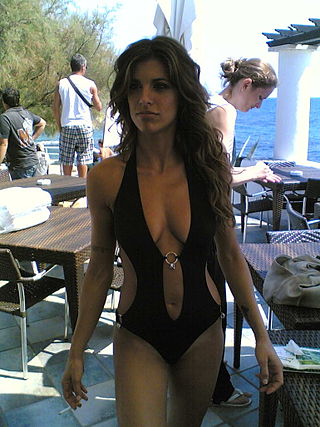
The sling swimsuit is a one-piece swimsuit which is supported by fabric at the neck. Sling swimsuits provide as little coverage as, or even less than, a bikini. Monokini types also exist. The sling swimsuit is also known by a variety of names including "suspender bikini", "sling bikini", "slingkini", "suspender thong", "slingshot swimsuit" or just "slingshot". It is so named because of its resemblance to the Y-shape frame of a slingshot. It is sometimes listed as a bikini variant. When designed for or worn by a man, it is often called a "mankini".

Israeli fashion refers to fashion design and modeling in Israel.
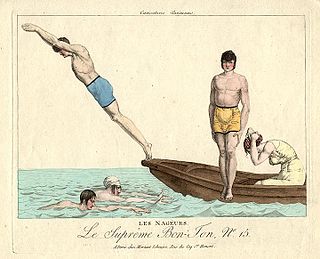
The history of swimwear traces the changes in the styles of men's and women's swimwear over time and between cultures, and touches on the social, religious and legal attitudes to swimming and swimwear.
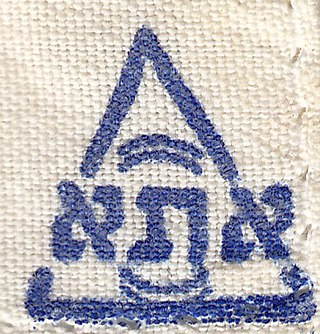
ATA Textile Company Ltd. was one of the first industrial enterprises founded in Israel, established in 1934. It was the first company in Israel to manufacture and design textiles locally. The textile factory continued to grow until the 1970s, and closed in 1985. ATA was re-established as a fashion brand in 2016 and is now based in Tel Aviv.
Monika Tilley was an Austrian-born American designer noted for designing loungewear and activewear. Many of her designs were featured on models in publications including the Sports Illustrated Swimsuit Issues. She focused on functional design and some of her designs were considered racy and provocative for their times. She was a founding member of the Council of Fashion Designers of America and two time recipient of the Coty American Fashion Critics' Award in the swimwear category.
Robin Piccone is an American fashion designer known for pioneering the use of neoprene in her scuba style swimwear under the Body Glove label. Robin Piccone is often affectionately called the “Queen of Neoprene” due to her pioneering work with the material in swimwear design.
TA3 Inc. is an American swimwear company founded in Los Angeles, California, in 2019 by fashion designer Leila Shams. The company is known for its body-sculpting swimwear, including corset-inspired swimwear and ready-to-wear apparel. TA3 Swim's designs have been worn by Beyonce, Billie Eilish, Remi Bader, Bebe Rexha, January Jones, Ashley Graham, and Drew Barrymore.